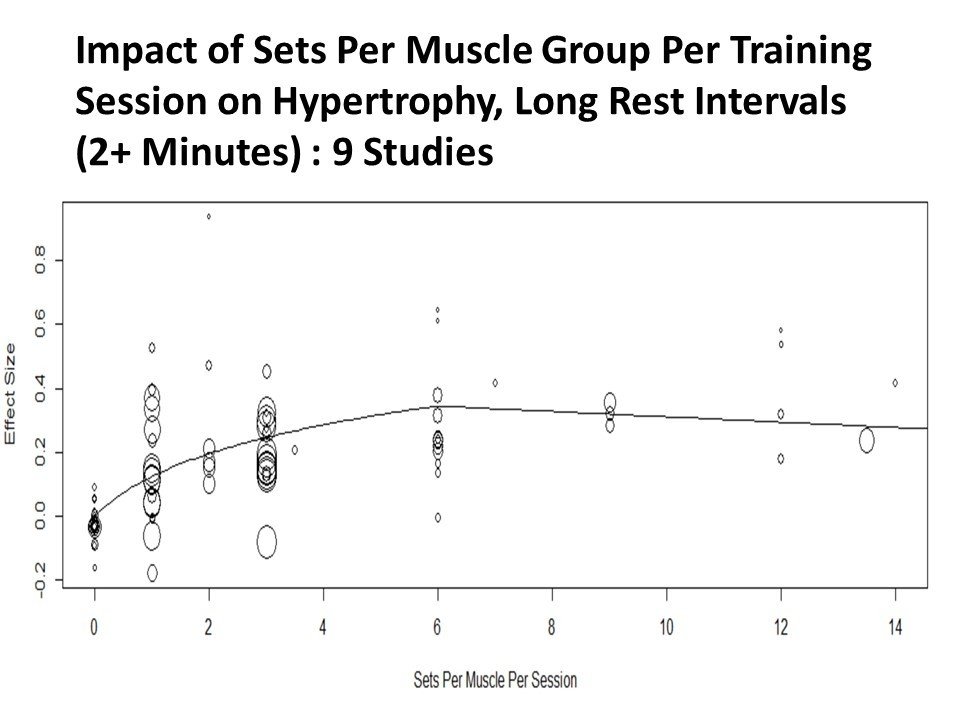Max sets per muscle group per session
When most people start lifting weights, they do so with tons of motivation, enthusiasm and vigour. This is good as they have to be super motivated – it takes a lot to take someone from the sofa to the squat rack. But, as good as this is, it often results in people doing far too much too soon, and this overzealous approach to training can often do more harm than good! You can't dive into training like you're starring in your own Rocky film without your body feeling like you've gone 12 rounds with Clubber Lang and subsequently struggling to recover from the pounding you've bestowed upon it.
Prefer to watch than read? Then please check out the video below:
Evidence-based recommendations
Many studies have observed the effects of different volumes in a single session – volume being total work – weight x reps x sets. Let's take a look at this in house meta-analysis done by James Krieger that reviewed the data of 9 separate studies, looking at the impact of sets per muscle group per session on muscle building.
The data is beautifully illustrated in this graph and shows that up to 6 sets per muscle group, the gains continue to rise, but beyond, we get hit with a pretty hard plateau. Some will benefit from 8 sets per muscle group, but few will reap the benefits beyond this. So, it's clear that more work doesn't always equal more gains, and if you look at the end of the scale, the extra work becomes detrimental. Now, you can see variants in the data, as everyone is different – individual volume response will differ, and some genetic monsters will continue to see benefits way beyond 6-8 sets per muscle group. Others won't even reach 6 sets before they start seeing diminishing returns.
Programming recommendations
When people start their lifting journey, they start with a traditional 'bro split', which involves destroying a single muscle group during a session. A 'bro split' will generally involve 5 or more exercises with 3-4 sets per exercise, so that's 15-20 sets per session. With this split, most people (bar a few extreme genetic monsters) will have a vast number of wasted sets – in fact, over half the session will be wasted. This is why many people run out of steam after they start their fitness journey – they put in 100% but don't get the results that reflect their effort. What they do get is a body that feels like it’s been hit by a bus.
To prevent diminishing returns or overtraining, you need to train smart and effectively manage your training volume. Instead of squeezing all your chest exercises into one session, spread it out through the week with full-body training. This type of training is the best way to prevent wasted sets each session – this is because you're spreading individual muscle group volume through the week instead of squeezing it all into one session!
The 6-8 sets per muscle group per session is not something I'm recommending everyone strive for, as the 6-8 sets are the upper end where many will no longer see a return on investment. If you're doing full-body training and training 3-4 times per week, you'll only need to do 3-5 hard working sets per muscle group to land in the effective weekly hypertrophy range of 10-20 sets per muscle group a week.
Important point
Again, I want to emphasise that science gives us ranges, and individuals respond differently – for you genetically enhanced superhumans, feel free to bump up the volume! But, us mere mortals, we need to train smart!
Summary
Training more is not always better – it may well result in diminishing returns or even overtraining where your body struggles to recover from the sessions – doing more worse than good! Training is not just about quantity – it's about quality, and the stress of training needs to be managed to get the most out of your training and recovery. You want to stimulate the body to induce muscle protein synthesis but not annihilate it – you can't BUILD the body you want if you keep smashing it to the ground!



